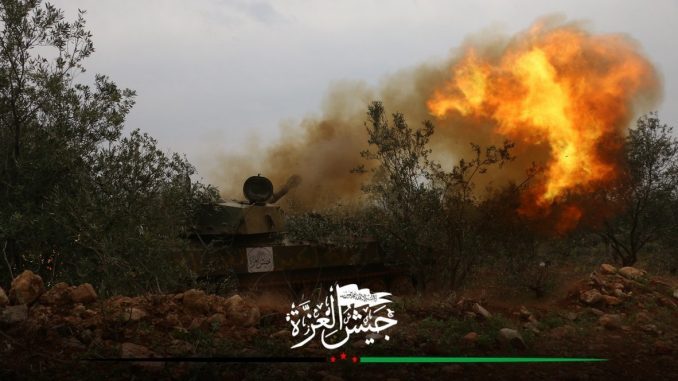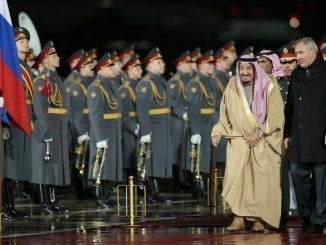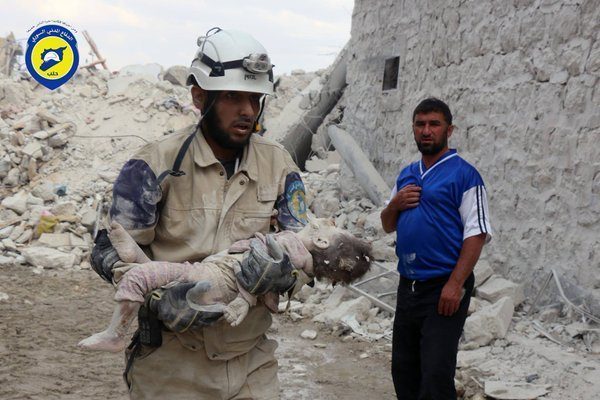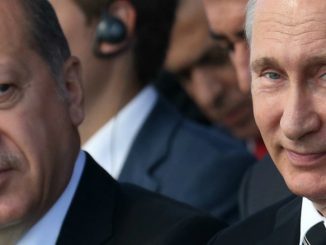
Assad regime forces fought fiercely in Syria’s Hama to reverse the revolutionaries’ latest advancement, as warplanes pounded the rebel-held areas heavily and reports said that signs of chemical attacks were clearly found.
Alliance of revolutionaries and militants launched a new offensive in Hama countryside on March 21 with the aim of retaking areas captured by government forces in 2016 and pushed into Hama city.
At least 10 rebel groups battling as part of the Free Syrian Army are also engaged in heavy fighting in northern Hama.
The Ahrar al-Sham rebel group, once the strongest in Syria’s north, announced on Tuesday that it too had begun an offensive in Hama.
Ahrar al-Sham military spokesman Omar Khattab announced in a video posted to YouTube the beginning of a new stage of fighting “against this criminal regime and against its sectarian militias”.
Ahrar al-Sham appears to have entered the fight in Hama as part of a separate operation because of recent clashes between it and Tahrir al-Sham in Syria’s north.
Since the offensive started, the revolutionaries made advancement in more than 12 villages and moved closer to Hama city. The revolutionaries also managed to cut off the supply route of regime forces from Hama to al-Ghab Plain in its northern countryside by controlling important fronts in the vicinity.
Russian airstrikes, heavy clashes
Warplanes pounded rebel-held areas north of the Syrian city of Hama on Thursday in an escalation of airstrikes aiming at reversing the revolutionaries’ advancement.
The Syrian Observatory for Human Rights said jets had hit several rebel-held towns on Thursday, including Soran and Khattab, both captured by revolutionaries at the start of the offensive.
The Assad regime forces source said the army was conducting attack operations in the area and had seized the initiative back from the revolutionaries.
Mohammed Rasheed, a spokesman for the Jaysh al-Nasr rebel group fighting in Hama under the FSA banner, said government and Russian “air strikes have been ramped up terribly”.
“The Russian warplanes have not stopped since last night,” he said.
The Russian Defence Ministry said on Tuesday that Syrian government forces with Russian air support had “eliminated” more than 2,100 rebel fighters over the past four days, the state-run TASS news agency reported.
Colonel-General Sergey Rudskoy told the press that Tahrir al-Sham had deployed 10,000 fighters to Hama.
The Observatory added that clashes continue in the areas of Bridij and al-Moghir in the northwestern countryside of Hama between the regime forces and the revolutionaries, and information from the ground pointed out that more casualties in the ranks of both parties happened.
In addition, the regime forces managed to advance further in the northern countryside of Hama and complete control over the village of Arzah
The clashes were accompanied by intense exchange of shelling between both parties, the Observatory added.
#Hama: Rebels repelling pro-#Assad forces at #Khattab today.https://t.co/TYjAUUjquH pic.twitter.com/1A6OVsfUOy
— WorldOnAlert (@worldonalert) March 30, 2017
#Hama: Rebels shelling #Assad regime positions in northwestern #Hama with artillery, Grad rockets and tanks. pic.twitter.com/WVJcrTo5SY
— WorldOnAlert (@worldonalert) March 29, 2017
On Tuesday I said that rebels have 72 hours to launch new attacks in #Hama to avoid an #Assad regime counter-offensive. Situation today: pic.twitter.com/Rja01Dft4i
— WorldOnAlert (@worldonalert) March 30, 2017
Suspected gas attacks
The Observatory and a doctor said air strikes near the town of Latamneh, northwest of Hama, had led several people to choke, saying it was a sign of a gas attack. A source close to regime’s military denied the army had used any such weapons, branding the reports as rebel propaganda.
Regime helicopters targeted the town of Al-Latamna and the village of Zawr with barrel bombs containing chlorine gas, Mohamed Elwan, a Hama-based doctor, told Anadolu Agency.
The gas, he said, had adversely affected roughly 100 residents of the opposition-held town and village, some of whom, he asserted, were in critical condition.
“Local residents are showing symptoms of chlorine gas exposure, including vomiting, dizziness, blurred vision and shortness of breath,” Elwan said.
Speaking to Reuters from Turkey, Abdallah Darwish, head of the health authority for rebel-held parts of Hama province, said air strikes in the south of Latamneh on Thursday morning had injured many people.
“The bombardment had a substance that caused intense irritation, heavy foaming from the mouth, and constricting pupils,” said Darwish, citing his medical staff on the ground.
A chemical attack hit the same area on Saturday, killing an orthopedic doctor, Darwish added.
On Wednesday, Syrian regime forces carried out a similar chlorine gas attack on the Al-Qaboun district northeast of capital Damascus that reportedly affected 35 civilian residents.
The regime source said the allegations that government forces were using chemical weapons were “devoid of truth”.
“The army has not, will not, and does not need to use these weapons,” the source said.
S.O.S. 175 patients with symptoms of exposure to strange chemical agent admitted to hospitals north of #Hama after #Assad jets attack @CNN pic.twitter.com/h5gwEgqeNE
— Zaher Sahloul (@sahloul) March 30, 2017
Political opposition denounces
The National Coalition of opposition forces denounces the chemical attacks in a statement, calling for bringing Assad regime figures to the International Criminal Court.
“The Assad regime’s air force bombed the town of Latamina and the Zwar area in northern rural of Hama with missiles loaded with toxic substances on Thursday. A similar attack targeted the district of Qaboun in eastern Damascus on Wednesday. The attacks caused dozens of cases of asphyxiation among civilians, with victims showing symptoms that included frothing at the mouth, pinpoint pupils, shortness of breath, burning eyes, and general weakness. According to a doctor who treated some of the victims, the symptoms were most likely due to the use of organic phosphorus,” the statement said.
“The Assad regime once again uses toxic gas in the bombardment of civilian areas in a blatant violation of the Geneva Protocol and UN Security Council resolutions 2118, 2209, 2235, and 2254.”
“The recurrence of these crimes and violations as well as lack of appropriate response make key parties in the UN Security Council and the international community partners in these crimes and violations.”
“The Coalition renews calls to refer the crimes of the Assad regime and its allies to the International Criminal Court to ensure that those responsible for crimes against humanity and war crimes are held accountable. Judicial proceedings should be instituted based on the mechanism adopted by the UN General Assembly on December 21, 2016 calling for prosecuting the most serious crimes committed in Syria since March 2011,” the statement finalized.
#PressRelease#Assad Reg Uses Toxic Gas in #Hama& #Damascushttps://t.co/ZvE3IyiyJN#Syria #ChemicalWeapons #BreathingChemicals #AssadCrimes pic.twitter.com/NnW8hUZhFn
— Syrian Coalition (@SyrCoalition) March 30, 2017
The Syrian crisis began as a peaceful demonstration against the injustice in Syria. Assad regime used to fire power and violence against the civilians and led to armed resistance. 450.000 Syrians lost their lives in the past five years according to UN estimates, and more than 12 million have lost their homes.



